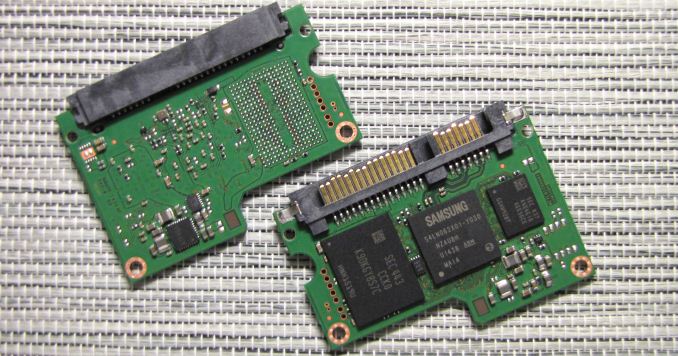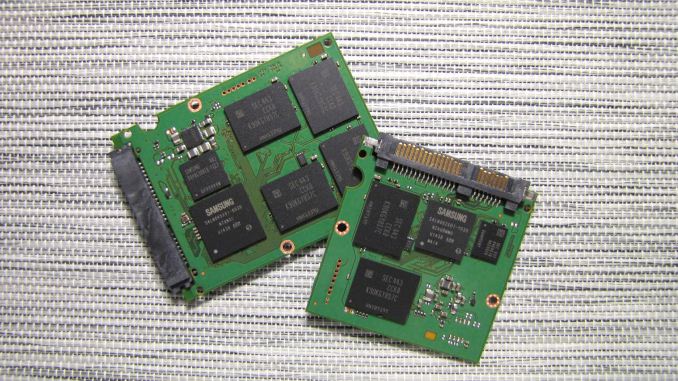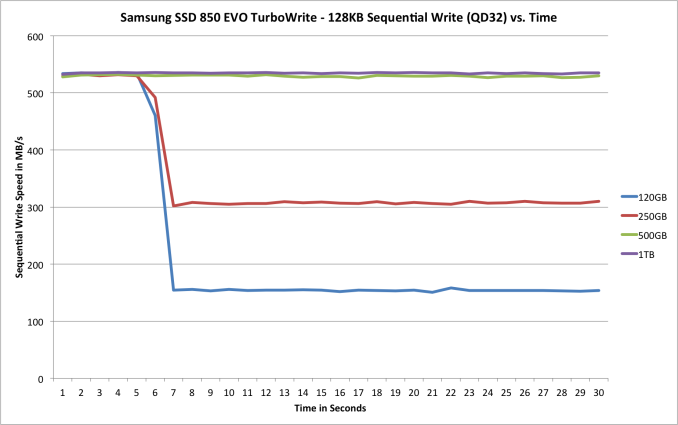Samsung SSD 850 EVO (120GB, 250GB, 500GB & 1TB) Review
by Kristian Vättö on December 8, 2014 10:00 AM ESTInside The Drives
There are three different PCB designs in the 850 EVO lineup. The 120GB and 250GB models (above) use a tiny PCB with room for two NAND packages (one on each side). Interestingly enough, both use octal-die packages, meaning that the 120GB 850 EVO only has a single 128GB (8*16GB) NAND package. Decoding the part number reveals that the packages are equipped with eight chip enablers (CEs), so a single NAND package is viable since all eight dies can be accessed simultaneously.
The use of octal-die packages is actually true for all capacities. It's an interesting choice nevertheless, but I suspect Samsung's packaging technology is advanced and mature enough that it's more cost efficient to use high die count packages and small PCBs instead of larger PCBs with more and less dense NAND packages.
| Samsung SSD 850 EVO NAND Configurations | ||||
| Capacity | 120GB | 250GB | 500GB | 1TB |
| # of NAND Packages | 1 | 2 | 4 | 8 |
| # of Die Per Package | 8 | 8 | 8 | 8 |
| Total # of Die | 8 | 16 | 32 | 64 |
| Die Capacity | 128Gbit | 128Gbit | 128Gbit | 128Gbit |
| Raw NAND Capacity | 128GiB | 256GiB | 512GiB | 1024GiB |
| Over-Provisioning | 12.7% | 9.1% | 9.1% | 9.1% |
TurboWrite
TurboWrite is a feature that Samsung brought to the 840 EVO to increase write performance. The idea of running a small portion of the NAND in SLC mode was nothing new, but it was the first time it truly made sense because the 840 EVO used slower TLC NAND and hence the SLC buffer could provide significant improvements to write performance and user experience. Unsurprisingly, TurboWrite is also present in the 850 EVO.
| Samsung SSD 850 EVO TurboWrite SLC Buffer Size | ||||
| Capacity | 120GB | 250GB | 500GB | 1TB |
| TurboWrite Buffer Size | 3GB | 3GB | 6GB | 12GB |
The buffer sizes and core architecture have remained unchanged. All writes hit the SLC buffer first, from which they then get moved to the TLC array during idle time. The only exception is a case of long, sustained period of writes that exceeds the buffer size, in which case the data will be written straight to the TLC portion.
| Write Performance With and Without TurboWrite | ||||
| With TurboWrite | Without TurboWrite | |||
| Sequential Write | 4KB Random Write (QD32) | Sequential Write | 4KB Random Write (QD32) | |
| 120GB | 520MB/s | 88K IOPS | 150MB/s | 38K IOPS |
| 250GB | 520MB/s | 88K IOPS | 300MB/s | 70K IOPS |
| 500GB | 520MB/s | 90K IOPS | 500MB/s | 80K IOPS |
| 1TB | 520MB/s | 90K IOPS | 520MB/s | 80K IOPS |
Samsung's reviewer's guide states that the 850 EVO features "enhanced TurboWrite technology" with a focus on random write performance, but I don't have any additional details as to how the TurboWrite implementation in the 850 EVO differs from the 840 EVO. TurboWrite was always designed to cache all writes regardless of the nature of the write (random vs sequential), so I'm not sure if anything has actually changed. Obviously the algorithms have been optimized for the new NAND and controller architecture and it's possible that the whole batch of algorithms has improved in the process, but I'll provide an update when I hear back from Samsung.
I ran a quick sequential write test to see how TurboWrite behaves in the 850 EVO. At smaller capacities it clearly provides a tremendous performance boost, but at 500GB and 1TB there is enough NAND to provide the parallelism that is needed to max out the SATA 6Gbps interface. That is a big improvement over the 840 EVO as its write performance maxed out at ~400MB/s when writing to the TLC array, so the performance benefits of 3D NAND technology are already evident.













97 Comments
View All Comments
eanazag - Monday, December 8, 2014 - link
Turbowrite is a default feature. It is marketing speak for optimizations to increase write performance in write workloads. It can't be turned on or off.erple2 - Wednesday, December 10, 2014 - link
Well, it has to be able to be turned on/off, as Kristian has a chart showing the difference in write speeds with it on/off. However, unlike "RAPID", there is no downside to leaving it on.geniekid - Monday, December 8, 2014 - link
Well written conclusion.andrewbaggins - Monday, December 8, 2014 - link
It's hard to understand why your SSD reviews fail to include Idle Power Consumption charts. For the hundreds of millions of PCs and laptops in use which do not support the so-called Slumber Power it would be far more useful if you included a chart for typical or average power consumed during Idle state.metayoshi - Monday, December 8, 2014 - link
"Hundreds of millions of PCs and laptops in use which do not support the so-called Slumber Power."Woah... I don't know where you got that "hundreds of millions" number from, but any system that supports SATA is able to support Slumber. Slumber has been in the SATA spec since forever, and pretty much all 2.5" drives, and some 3.5" drives support this power state.
metayoshi - Monday, December 8, 2014 - link
P.S. As an example, I have a Core 2 Quad Q6600 sitting in my cubicle at work on an Asus PSE WS Pro motherboard. I have no Idea how old this thing is, but it's running a SATA-II 3.0 Gbps interface, and that great grandfather of a system supports HIPM+DIPM, and does Partial and Slumber on a variety of SSDs and HDDs.eanazag - Monday, December 8, 2014 - link
Newegg has a promotion for these drives ending 12/14/14 (US $) -120GB @ $89.99
250GB @ $139.99
500GB @ $249.99
1TB @ $469.99
eddieobscurant - Monday, December 8, 2014 - link
I think an 120gb 850 evo usb thumb drive would be awesome .dwade123 - Monday, December 8, 2014 - link
Realworld: all modern ssds have similar windows boot and game loading time. All these synthetic tests are just for reviewers to have something talk about, and marketing purposes. Meh.StrangerGuy - Monday, December 8, 2014 - link
I would rather want a SSD that has 90% of a MX100 but only 50% dollar per GB, instead of extra performance that 99% of SSD buyers will not never benefit for more money.